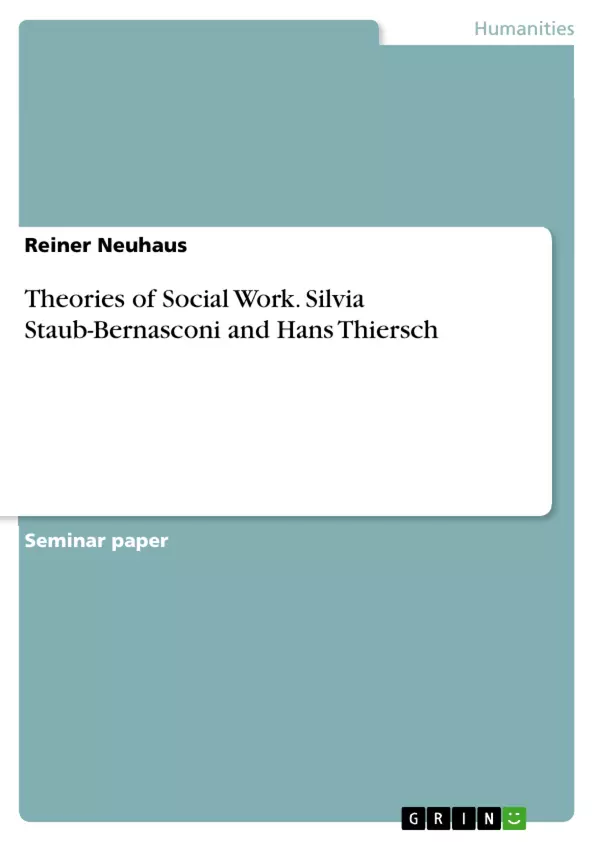As the title of the work suggests, in the following four chapters I deal with two of the great theories of social work. I have chosen the theories of Prof. Dr. Silvia Staub-Bernasconi and Prof. Dr. phil. Dr. Dres. h.c. Hans Thiersch. Silvia Staub-Bernasconi studied social work in Zurich and the USA, sociology, social psychology, pedagogy and social ethics at the University of Zurich and habilitated at the Technical University of Berlin. She was, among other things, Lecturer for Social Work and Human Rights at the University of Social Work in Zurich and the TU Berlin. Silvia Staub-Bernasconi coined the term social work as a human rights professional and also shaped the scientific understanding of social work as a science of action. She established theories for social work that were largely detached from the other works of great theorists such as Thiersch, Dewe/Otto and Bommes/Scherr (cf. Staub-Bernasconi, Soziale Arbeit als Handlungswissenschaft, Haupt Verlag, 2007). Hans Thiersch considers, among other things, in his theory on the "determination of the position of social work" (Hans Thiersch, 2002, Juventa Verlag Weinheim), the self-image of social work against the background of political constraints and economic interests. His individual activities and publications are so numerous and extensive that a list of them would go beyond the scope of this paper. He is considered the founder of the Tübingen School. His view of life-world orientation in social work influences the theories of Dewe/Otto and Bommes/Scherr.
A clear demarcation of the two theories I have chosen is not completely possible, despite their independence.
In the following, I will try to highlight serious differences as well as striking intersections and to critically examine their applicability in the socio-pedagogical field of inpatient and open and outreach work for children and young people.
Inhaltsverzeichnis (Table of Contents)
- Introduction.
- Brief introduction to the discussed theories..
- Silvia Staub-Bernasconi: Social work as a human rights professional and cause of unfulfilled legitimate desires and needs.
- Hans Thiersch: Lifeworld orientation
- Intersections and differences of the two aforementioned theories ...........\n
- Professional action
- Social problems ..
- Social work objectives
- Mandates of social work
- Technical-critical consideration\n
- Thiersch's theory in the everyday life of an inpatient youth welfare institution.......
- Staub-Bernasconi's theory in everyday life of residential care
- Conclusion.......
Zielsetzung und Themenschwerpunkte (Objectives and Key Themes)
This work aims to examine and compare two prominent theories of social work, those of Silvia Staub-Bernasconi and Hans Thiersch. The analysis focuses on their key concepts, differences, and potential applications within the socio-pedagogical field of inpatient and open outreach work for children and young people.
- Human rights professional approach to social work
- Lifeworld orientation in social work
- Social problems and their prevention
- The role of professional action in social work
- The relationship between social work and individual empowerment
Zusammenfassung der Kapitel (Chapter Summaries)
- Introduction: This chapter introduces the two theories that will be examined in the paper, providing brief biographical information on the authors and outlining the key themes of the work. It establishes the goal of highlighting both the differences and intersections of these approaches.
- Brief introduction to the discussed theories: This section provides a detailed overview of Silvia Staub-Bernasconi's and Hans Thiersch's theoretical frameworks. Staub-Bernasconi's theory focuses on social work as a human rights profession and addresses the issue of unfulfilled legitimate desires and needs as the root of social problems. Thiersch's theory emphasizes a lifeworld orientation, centering on the individual's experience and advocating for self-empowerment.
- Intersections and differences of the two aforementioned theories: This chapter delves deeper into the similarities and contrasts between Staub-Bernasconi's and Thiersch's theories across various aspects of social work practice. It examines their perspectives on professional action, social problems, social work objectives, and the mandates of social work.
- Technical-critical consideration: This chapter explores the practical application of these theories within specific settings. It examines how Thiersch's theory manifests in inpatient youth welfare institutions and how Staub-Bernasconi's approach operates in residential care settings.
Schlüsselwörter (Keywords)
Key terms and concepts that form the foundation of this work include social work theory, human rights professional approach, lifeworld orientation, social problems, professional action, empowerment, prevention, and social justice. These themes are explored through the lenses of the theories developed by Silvia Staub-Bernasconi and Hans Thiersch, providing a comprehensive overview of the contemporary landscape of social work practice.
- Quote paper
- Reiner Neuhaus (Author), 2012, Theories of Social Work. Silvia Staub-Bernasconi and Hans Thiersch, Munich, GRIN Verlag, https://www.grin.com/document/1169169



